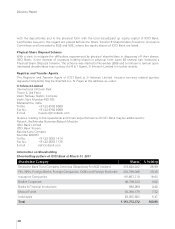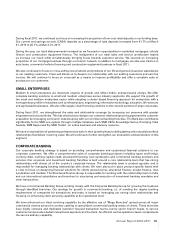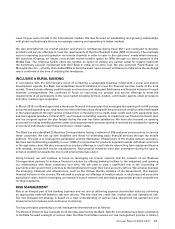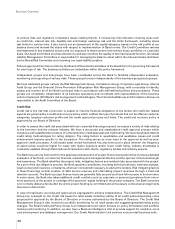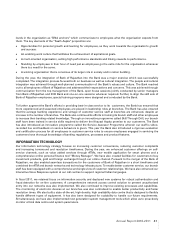ICICI Bank 2011 Annual Report Download - page 40
Download and view the complete annual report
Please find page 40 of the 2011 ICICI Bank annual report below. You can navigate through the pages in the report by either clicking on the pages listed below, or by using the keyword search tool below to find specific information within the annual report.
to various risks and regulatory compliance issues relating thereto. It reviews key risk indicators covering areas such
as credit risk, interest rate risk, liquidity risk and foreign exchange risk and the limits framework, including stress
test limits for various risks. It also carries out an assessment of the capital adequacy based on the risk profile of our
balance sheet and reviews the status with respect to implementation of Basel norms. Our Credit Committee reviews
developments in key industrial sectors and our exposure to these sectors and reviews major portfolios on a periodic
basis. Our Audit Committee provides direction to and also monitors the quality of the internal audit function. Our Asset
Liability Management Committee is responsible for managing the balance sheet within the risk parameters laid down
by the Board/Risk Committee and reviewing our asset-liability position.
Policies approved from time to time by the Board of Directors/Committees of the Board form the governing framework
for each type of risk. The business activities are undertaken within this policy framework.
Independent groups and sub-groups have been constituted across the Bank to facilitate independent evaluation,
monitoring and reporting of various risks. These groups function independently of the business groups/sub-groups.
We have dedicated groups namely the Risk Management Group, Compliance Group, Corporate Legal Group, Internal
Audit Group and the Financial Crime Prevention & Reputation Risk Management Group, with a mandate to identify,
assess and monitor all of the Bank’s principal risks in accordance with well-defined policies and procedures. These
groups are completely independent of all business operations and coordinate with representatives of the business
units to implement ICICI Bank’s risk management methodologies. The Internal Audit Group and Compliance Group are
responsible to the Audit Committee of the Board.
Credit Risk
Credit risk is the risk that a borrower is unable to meet its financial obligations to the lender. All credit risk related
aspects are governed by a credit and recovery policy which outlines the type of products that can be offered, customer
categories, targeted customer profile and the credit approval process and limits. The credit and recovery policy is
approved by our Board of Directors.
In order to assess the credit risk associated with any corporate financing proposal, we assess a variety of risks relating
to the borrower and the relevant industry. We have a structured and standardised credit approval process which
includes a well established procedure of comprehensive credit appraisal and credit rating. We have developed internal
credit rating methodologies for rating obligors. The rating factors in quantitative and qualitative issues and credit
enhancement features specific to the transaction. The rating serves as a key input in the approval as well as post-
approval credit processes. A risk based asset review framework has also been put in place wherein the frequency
of asset review would be higher for cases with higher exposure and/or lower credit rating. Industry knowledge is
constantly updated through field visits and interactions with clients, regulatory bodies and industry experts.
The Bank has a strong framework for the appraisal and execution of project finance transactions that involves a detailed
evaluation of technical, commercial, financial, marketing and management factors and the sponsor’s financial strength
and experience. The Bank identifies the project risks, mitigating factors and residual risks associated with the project.
As a part of the due diligence process, the Bank appoints consultants, including technical advisors, business analysts,
legal counsel and insurance consultants, wherever considered necessary, to advise the lenders. Risk mitigating factors
in these financings include creation of debt service reserves and channelling project revenues through a trust and
retention account. The Bank’s project finance loans are generally fully secured and have full recourse to the borrower.
In some cases, the Bank also takes additional credit comforts such as corporate or personal guarantees from one or
more sponsors of the project or a pledge of the sponsors’ equity holding in the project company. The Bank’s practice
is to normally disburse funds after the entire project funding is committed and all necessary contractual arrangements
have been entered into.
In case of retail loans, sourcing and approval are segregated to achieve independence. The Credit Risk Management
Group has oversight on the credit risk issues for retail assets including vetting of all credit policies/operating notes
proposed for approval by the Board of Directors or forums authorised by the Board of Directors. The Credit Risk
Management Group is also involved in portfolio monitoring for all retail assets and suggesting/implementing policy
changes. The Retail Credit and Policy Group is an independent unit which focuses on policy formulation and portfolio
tracking and monitoring. In addition, we also have a Business Intelligence Unit to provide support for analytics, score
card development and database management. Our Credit Administration Unit services various retail business units.
Business Overview
38


